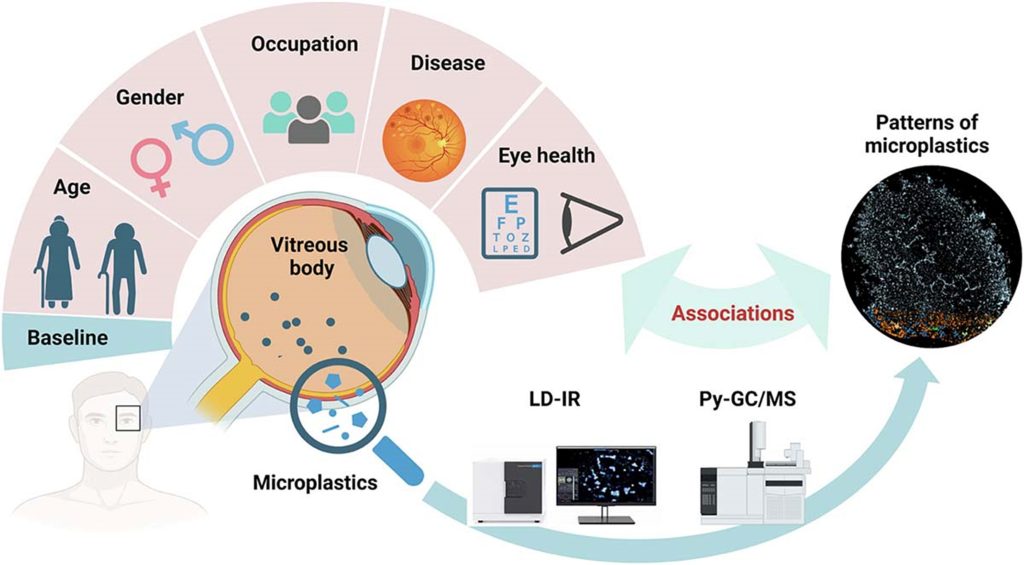Concern over ocular health effects of detected microplastics in the human vitreous humour.
Microplastics are environmental contaminants of growing concern due to the risks to human health from their presence in various biological samples, not least because a study recently published in "Science of The Total Environment', also detected them in thehuman vitreous humour.
Microplastics are particles that measure ≤5mm and are produced and released all over our planet. Between 1950 and 2015, an estimated 6.3 million tonnes of plastic waste were generated, leading to the release of microplastics through the various physical, chemical and biological processes in which such waste is involved. In the years following the outbreak of the Covid-19 pandemic, in particular, there has been a surge in the generation of plastic waste due to the mass use of single-use personal protective equipment (PPE).

Our body's exposure to microplastics occurs through various channels, including direct ingestion of food, drink and water containing microplastics, as well as through exposure to industrial pollution, traffic, building materials and cigarette smoke.
Ingestion, inhalation and contact are the main channels through which these particles enter the body and through numerous studies they have been found in a wide range of biological samples, including faeces, blood, placenta, lung tissue and thrombotic tissue. Furthermore, recent studies have shown that even contact lenses can release microplastics after prolonged exposure to sunlight, lasting more than 300 hours.
With regard to human ocular tissues, a team of researchers from the Translational Medicine Research Centre, Zhujiang Hospital in Guangzhou (China) investigated the presence of microplastics in the vitreous humour through analysis of 49 vitreous humour samples taken from patients suffering from four different pathological situations: macular hole, macular epiretinal membrane, retinopathy and rhegmatogenous retinal detachment. The recruited patients, aged between 30 and 80 years, came from two different medical centres and were 44.90% women and 55.10% men. The vitreous humour of all enrolled patients was analysed with the combined use of laser spectroscopy, direct infrared, and pyrolysis gas chromatography/mass spectrometry. The results revealed the presence of more than 8,500 particles, of which more than 1.700 identified as plastic particles. The predominant ones, mainly smaller than 50 μm, included nylon 66 (the most present), polyvinyl chloride and polystyrene.
Microplastics and eye health
The established presence of microplastics in the vitreous correlates with some key ocular health parameters. In particular, an association between microplastic levels and increased intraocular pressure (IOP) and the presence of aqueous humour opacity has been reported in cases of retinopathy.
Microplastics, as the study suggests, could also contribute to the onset of chronic inflammatory states, the risks of which are specifically discussed in our article on InflammAging and ocular surface - Oculist Italiano
The ocular health risks associated with the presence of microplastics in the vitreous humour should influence environmental and health management practices and suggest appropriate preventive measures.
- Zhong Y, Yang Y, Zhang L, et al. Revealing new insights: Two-center evidence of microplastics in human vitreous humor and their implications for ocular health. Sci Total Environ. 2024 Apr 15;921:171109. doi: 10.1016/j.scitotenv.2024.171109. Epub 2024 Feb 21. PMID: 38387563.
- J.P.G.L. Frias, Roisin Nash, Microplastics: Finding a consensus on the definition, Marine Pollution Bulletin, Volume 138, 2019, Pages 145-147, ISSN 0025-326X, https://doi.org/10.1016/j.marpolbul.2018.11.022.
- Rony Ibne Masud, Kamrul Hassan Suman, Shadia Tasnim, et al,A review on enhanced microplastics derived from biomedical waste during the COVID-19 pandemic with its toxicity, health risks, and biomarkers, Environmental Research,Volume 216, Part 1,2023,114434,ISSN 0013-9351, https://doi.org/10.1016/j.envres.2022.114434.
